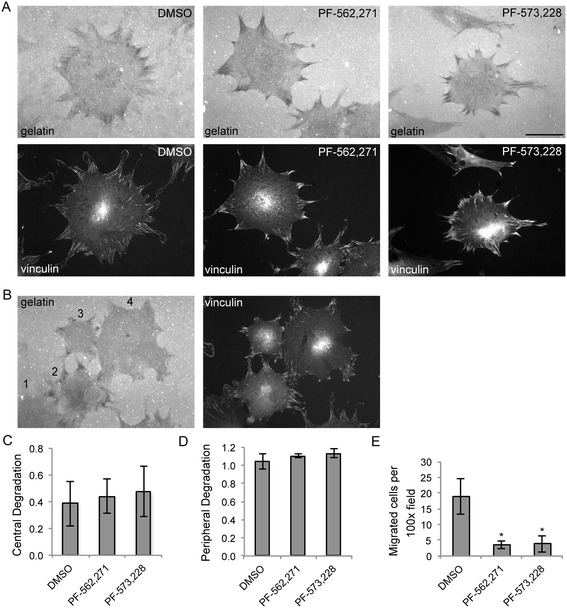Figure 3.

Focal adhesion kinase inhibitors do not alter focal matrix degradation, but do reduce migration of rheumatoid synovial fibroblasts. (A) Rheumatoid synovial fibroblasts were treated with PF-562,271, PF-573,228 or dimethyl sulfoxide (DMSO) as the vehicle control, plated on fluorescently labeled gelatin, fixed after 5 hours and stained for vinculin. Representative images of matrix-degrading cells from each condition are displayed (n = 3 independent experiments using cell lines from two different patients). Images were created at 400× magnification, and the bar represents 50 μm. (B) Left panel depicts a scoring system for gelatin degradation: 1 = no peripheral degradation (note: for quantitative analyses in (C) and (D), only cells that were completely within the field of view were scored), 2 = central and severe peripheral degradation, 3 = severe peripheral degradation and no central degradation and 4 = mild peripheral degradation and no central degradation. Cells treated as in (A) were scored for degradation as described in for (B). (C) and (D) Graphs show the average scores ± SEM for central (C) and peripheral (D) degradation (n = 3 independent experiments using cell lines from two different patients). (E) Rheumatoid synovial fibroblasts were treated with PF-562,271, PF-573,228 or vehicle control (DMSO) and allowed to migrate for 5 hours across a transwell. The graph shows average number ± SEM of migrated cells per microscopic field at 100× magnification (n = 4 independent experiments using cell lines from three different patients, *P < 0.05 by one-way analysis of variance).
